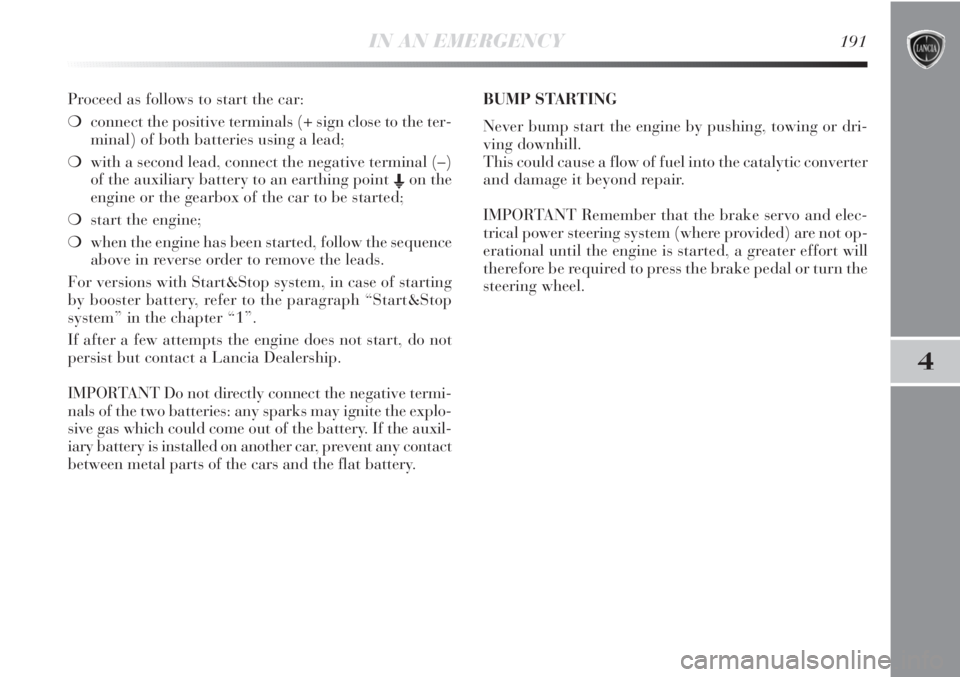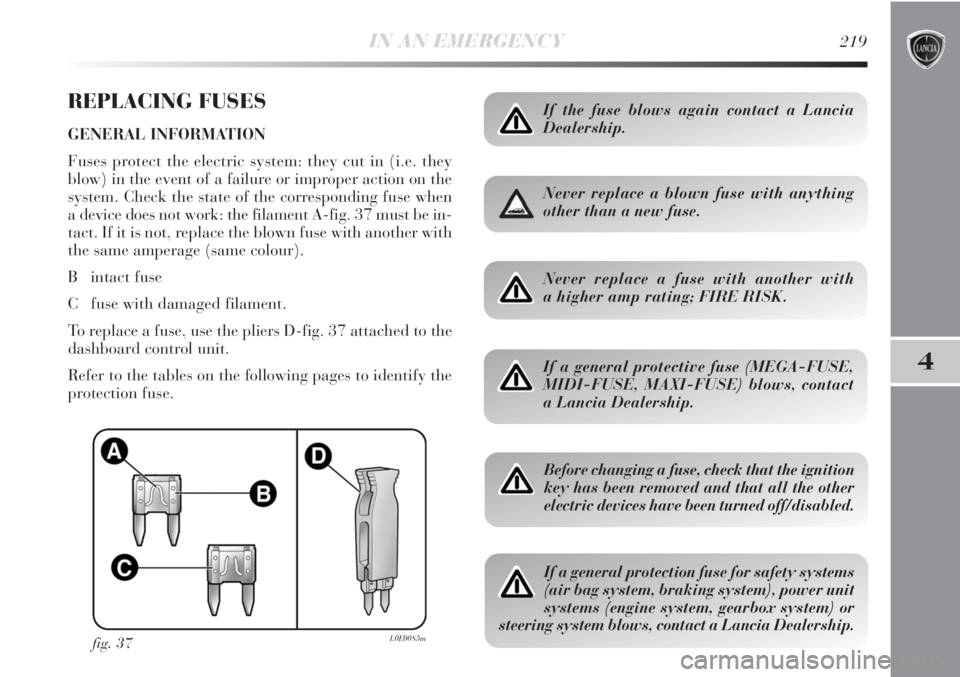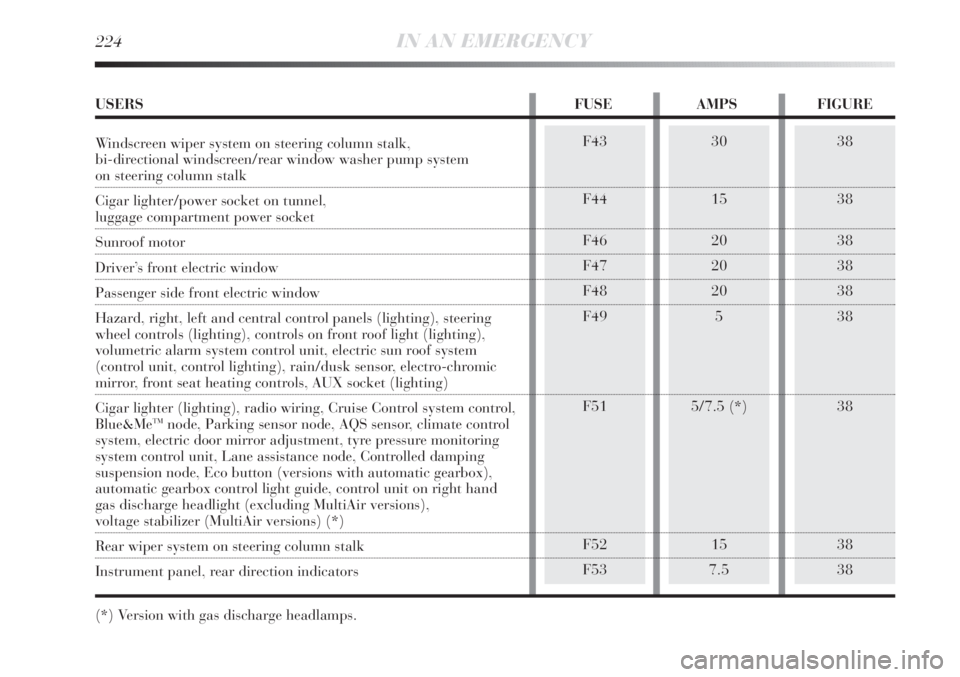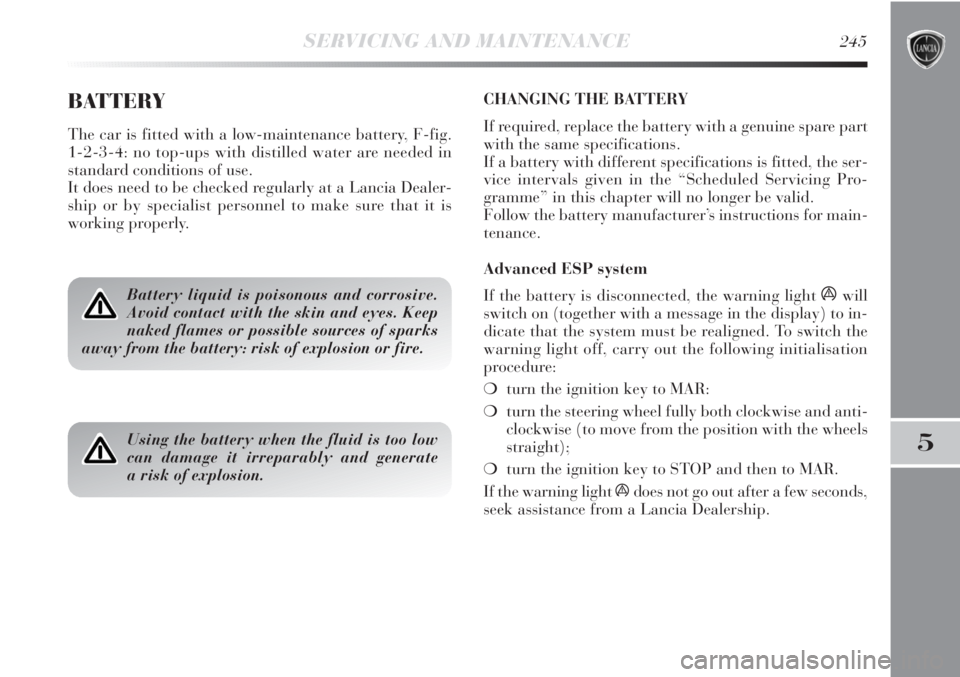steering Lancia Delta 2012 Owner handbook (in English)
[x] Cancel search | Manufacturer: LANCIA, Model Year: 2012, Model line: Delta, Model: Lancia Delta 2012Pages: 295, PDF Size: 8.29 MB
Page 193 of 295

IN AN EMERGENCY191
4
Proceed as follows to start the car:
❍connect the positive terminals (+ sign close to the ter-
minal) of both batteries using a lead;
❍with a second lead, connect the negative terminal (–)
of the auxiliary battery to an earthing point E
on the
engine or the gearbox of the car to be started;
❍start the engine;
❍when the engine has been started, follow the sequence
above in reverse order to remove the leads.
For versions with Start&Stop system, in case of starting
by booster battery, refer to the paragraph “Start&Stop
system” in the chapter “1”.
If after a few attempts the engine does not start, do not
persist but contact a Lancia Dealership.
IMPORTANT Do not directly connect the negative termi-
nals of the two batteries: any sparks may ignite the explo-
sive gas which could come out of the battery. If the auxil-
iary battery is installed on another car, prevent any contact
between metal parts of the cars and the flat battery.BUMP STARTING
Never bump start the engine by pushing, towing or dri-
ving downhill.
This could cause a flow of fuel into the catalytic converter
and damage it beyond repair.
IMPORTANT Remember that the brake servo and elec-
trical power steering system (where provided) are not op-
erational until the engine is started, a greater effort will
therefore be required to press the brake pedal or turn the
steering wheel.
Page 202 of 295

200IN AN EMERGENCY
The driving characteristics of the car may
change when a space-saver wheel is fitted.
Avoid sudden acceleration and braking, sud-
den steering and fast cornering. The total life of
a space-saver wheel is approximately 3000 km,
after which it must be replaced by another wheel of
the same type. Never attempt to fit a conventional
tyre on a rim designed for use as a space-saver
wheel. Have the punctured wheel repaired and re-
placed as soon as possible. Two or more space-
saver wheels should never be used together. Do not
apply grease to the bolt threads before assembly:
they might spontaneously unscrew.The jack can only be used for changing
wheels on the car with which it is provided or
on cars of the same model Never use the jack
for other purposes, such as lifting other car models.
In no case should it be used for repairs under the
car. Incorrect positioning of the jack may cause the
jacked car to fall. Do not use the jack for loads
higher than those shown on the label. Snow chains
cannot be fitted to the space-saver wheel. So, if
a front (drive) wheel is punctured and chains are
needed, a rear wheel should be fitted to the front of
the car and the space-saver wheel should be fitted
to the rear. This way, with two normal front driving
wheels, you can install the snow chains on them,
thus resolving the emergency.
If the hub cap is not installed properly, it
may detach when the vehicle is running.
Never tamper with the inflation valve. Never
introduce tools of any kind between rim and tyre.
Regularly check tyre and space-saver wheel pres-
sure, complying with the data in the chapter “6”.
Tool box (versions with Bose HI-FI)
There is a tool box located in the luggage compartment
for versions with Bose HI-FI.
This box contains:
❍screwdriver;
❍tow hook;
❍wheel bolt spanner;
❍wheel bolt access spanner;
❍alloy wheel centring device;
❍jack.
Page 221 of 295

IN AN EMERGENCY219
4
REPLACING FUSES
GENERAL INFORMATION
Fuses protect the electric system: they cut in (i.e. they
blow) in the event of a failure or improper action on the
system. Check the state of the corresponding fuse when
a device does not work: the filament A-fig. 37 must be in-
tact. If it is not, replace the blown fuse with another with
the same amperage (same colour).
B intact fuse
C fuse with damaged filament.
To replace a fuse, use the pliers D-fig. 37 attached to the
dashboard control unit.
Refer to the tables on the following pages to identify the
protection fuse.
fig. 37L0E0085m
If the fuse blows again contact a Lancia
Dealership.
Never replace a blown fuse with anything
other than a new fuse.
Never replace a fuse with another with
a higher amp rating; FIRE RISK.
If a general protective fuse (MEGA-FUSE,
MIDI-FUSE, MAXI-FUSE) blows, contact
a Lancia Dealership.
Before changing a fuse, check that the ignition
key has been removed and that all the other
electric devices have been turned off/disabled.
If a general protection fuse for safety systems
(air bag system, braking system), power unit
systems (engine system, gearbox system) or
steering system blows, contact a Lancia Dealership.
Page 226 of 295

224IN AN EMERGENCY
38
38
38
38
38
38
38
38
38F43
F44
F46
F47
F48
F49
F51
F52
F5330
15
20
20
20
5
5/7.5 (*)
15
7.5
USERS FUSE AMPS FIGURE
Windscreen wiper system on steering column stalk,
bi-directional windscreen/rear window washer pump system
on steering column stalk
Cigar lighter/power socket on tunnel,
luggage compartment power socket
Sunroof motor
Driver’s front electric window
Passenger side front electric window
Hazard, right, left and central control panels (lighting), steering
wheel controls (lighting), controls on front roof light (lighting),
volumetric alarm system control unit, electric sun roof system
(control unit, control lighting), rain/dusk sensor, electro-chromic
mirror, front seat heating controls, AUX socket (lighting)
Cigar lighter (lighting), radio wiring, Cruise Control system control,
Blue&Me
TMnode, Parking sensor node, AQS sensor, climate control
system, electric door mirror adjustment, tyre pressure monitoring
system control unit, Lane assistance node, Controlled damping
suspension node, Eco button (versions with automatic gearbox),
automatic gearbox control light guide, control unit on right hand
gas discharge headlight (excluding MultiAir versions),
voltage stabilizer (MultiAir versions) (*)
Rear wiper system on steering column stalk
Instrument panel, rear direction indicators
(*) Version with gas discharge headlamps.
Page 230 of 295

228IN AN EMERGENCY
When towing, remember that without the
help of the brake servo and electric power
steering, a greater effort is required on the
pedal and steering wheel. Do not use flexible ca-
bles when towing and avoid jerky movements.
While towing, make sure not to damage parts in
contact with the car. When towing the vehicle, it is
compulsory to respect specific highway code reg-
ulations relating to the tow hook and procedures for
towing on the road. Do not start the engine while
towing the car. Before tightening the ring clean the
threaded housing thoroughly. Make sure that the
ring is securely fastened before towing the car.
The front and rear tow hooks must only be
used for emergency situations on the road.
The car may be towed for short distances
when a dedicated device is used in compliance with
the Highway Code (rigid bar), and in order to move
the vehicle on the road in preparation for towing by
a tow truck. Tow hooks MUST NOT be used to tow
vehicles off the road or where there are obstacles
and/or for towing operations using cables or other
non-rigid devices. Respecting the above conditions,
towing must take place with two vehicles (one tow-
ing, the other towed) aligned as much as possible
along the same centre line.
fig. 45L0E0091m
Before towing, turn the ignition key to MAR
and then to STOP without removing it. The
steering column will automatically lock
when the key is removed and the wheels cannot be
steered.
Page 247 of 295

SERVICING AND MAINTENANCE245
5
BATTERY
The car is fitted with a low-maintenance battery, F-fig.
1-2-3-4: no top-ups with distilled water are needed in
standard conditions of use.
It does need to be checked regularly at a Lancia Dealer-
ship or by specialist personnel to make sure that it is
working properly.
Battery liquid is poisonous and corrosive.
Avoid contact with the skin and eyes. Keep
naked flames or possible sources of sparks
away from the battery: risk of explosion or fire.
Using the battery when the fluid is too low
can damage it irreparably and generate
a risk of explosion.
CHANGING THE BATTERY
If required, replace the battery with a genuine spare part
with the same specifications.
If a battery with different specifications is fitted, the ser-
vice intervals given in the “Scheduled Servicing Pro-
gramme” in this chapter will no longer be valid.
Follow the battery manufacturer’s instructions for main-
tenance.
Advanced ESP system
If the battery is disconnected, the warning light
áwill
switch on (together with a message in the display) to in-
dicate that the system must be realigned. To switch the
warning light off, carry out the following initialisation
procedure:
❍turn the ignition key to MAR:
❍turn the steering wheel fully both clockwise and anti-
clockwise (to move from the position with the wheels
straight);
❍turn the ignition key to STOP and then to MAR.
If the warning light ádoes not go out after a few seconds,
seek assistance from a Lancia Dealership.
Page 250 of 295

248SERVICING AND MAINTENANCE
WHEELS AND TYRES
Check the pressure of each tyre, including the space-saver
wheel, approximately every two weeks and before long
journeys: the pressure should be checked with the tyre
rested and cold.
It is normal for the pressure to increase as the car is used;
see the “Wheels” paragraph in chapter “6” for the cor-
rect tyre inflation pressure.
Incorrect pressure causes abnormal tyre wear fig. 5:
A normal pressure: tread evenly worn.
B low pressure: tread particularly worn at the edges.
C high pressure: tread particularly worn in the centre.
The tyres must be replaced when the tread is less than
1.6 mm thick. In all cases, follow the laws in force in
the country where you are driving.
fig. 5L0E0096m
IMPORTANT NOTES
❍Where possible, avoid braking suddenly, wheel-spin-
ning and crashing into curbs, potholes or other ob-
stacles. Driving for long stretches over bumpy roads
can damage the tyres;
❍check the tyres regularly for cuts on the sides, swelling
or irregular tread wear. Go to a Lancia Dealership
if required.
❍avoid overloading the car when travelling: this may
cause serious damage to the wheels and tyres;
❍if a tyre is punctured, stop immediately and change
it to avoid damage to the tyre, wheel rim, suspension
and steering system;
❍the tyre ages even if rarely used. Cracks in the tread
and on the sidewalls are a sign of ageing. Have the
tyres checked by skilled personnel if they have been
fitted for longer than six years. Remember to check
the space-saver wheel very carefully;
Page 259 of 295

6
TECHNICAL SPECIFICATIONS257
Identification data .......................................................... 258
Engine codes – bodywork versions .................................. 260
Engine ............................................................................ 261
Fuel supply system ......................................................... 263
Transmission .................................................................. 264
Brakes ............................................................................. 264
Suspensions .................................................................... 265
Steering ........................................................................... 265
Wheels ............................................................................ 266
Dimensions ..................................................................... 271
Performance ................................................................... 272
Weights ........................................................................... 273
Capacities ....................................................................... 275
Fluids and lubricants ...................................................... 277
Fuel consumption ........................................................... 279
CO
2emissions ................................................................ 280
Page 267 of 295

Rack and pinion with electric power steering
10.6/11.2 (*)
TECHNICAL SPECIFICATIONS265
6
SUSPENSIONS
Mac Pherson independent wheels
Interconnected wheels with torsion beam
1.4 Turbo Jet – 1.4 Turbo Multi Air ––1.6 Multijet ––1.9 Twin Turbo Multijet – 2.0 Multijet
Gearbox
Parking brake
STEERING
(*) With 18" tyres
1.4 Turbo Jet – 1.4 Turbo Multi Air ––1.6 Multijet ––1.9 Twin Turbo Multijet – 2.0 Multijet
Ty p e
Steering circle
(kerb to kerb) m
Page 290 of 295

288LIST OF CONTENTS
– emergency rear door
locking device ................. 90
DPF (particulate filter) .......154
Driving Advisor ...................108
DST (Dynamic Steering
Torque) .............................105
“Dualdrive” electric
power steering ...................127
Electric windows ................. 90
Engine codes/
bodywork versions ............260
Engine compartment
(washing) ..........................255
Engine
– identification code ..........260
– specifications ..................261
EOBD system ......................127
Exterior lights ..................... 65
Fix&Go Automatic
(device) .............................192
Flashing .............................. 67
Fluids and lubricants ..........277
Fog lights ...................... 66-77
– bulb replacement ............213
– Cornering function ......... 66
Follow Me Home (device) ... 68
Food compartment .............. 80
Front/rear armrest ......... 79-81
Fuel cap ..............................153
Fuel consumption ...............279
Fuel cut-off ......................... 78
Fuses (if a fuse blows) .........219
Getting to know your car .... 7
Glove box light
(bulb replacement) ............218 Cruise Control ..................... 71
Cup holder/oddment
compartments ................... 82
Dashboard .......................... 8
Dimensions .........................271
Dipped headlamps (control) .. 67
– bulb replacement ............210
Direction indicators
– bulb replacement ............212
– control ............................ 67
Display ............................... 23
– display readings ............. 36
– menu items ..................... 28
Display readings ................. 36
Door locking ....................... 89
Doors .................................. 87
– child safety lock ............. 88